Round ten was a day of decisive games on the top ten boards in the Isle of Man Grand Swiss, with seven wins and three draws. The top players clearly knew there was no more point in holding back anymore and if they wanted to do something in the tournament, then penultimate round was a crucial milestone. After sharing the lead for 9 rounds of the tournament, World No 2 Fabiano Caruana finished round 10 as the sole player on the top. He defeated the Spaniard David Anton as White and enters the final round with a half-point ahead of the other top players. Chasing Caruana is a pack of seven GMs, which includes the World Champion Magnus Carlsen who, after victory in round nine, has also achieved his 100th game without losing. The final round of the Isle of Man Grand Swiss will see eight top players deciding who will be the winner of the $70,000 first prize and, also, who will win the race for the place in the 2020 Candidates’ tournament.
On the first board, Fabiano Caruana was playing as white against David Anton of Spain. In the English opening after a quick exchange of queens, a roughly even position emerged on the board. In 20 moves the opponents reached an endgame with a rook and a knight and seven pawns each. Caruana had a slight edge as of his pieces were more active and positioned more naturally, compared to Anton who had doubled pawns on the c and f-files.
The World No 2 opted for a push on the kingside, leaving Black to counterattack on the left flank. Caruana obtained a much better position, making it quite uncomfortable for the Spaniard who offered a move repetition but was refused. As the game progressed Caruana was slightly worse on time, but confidently secured his advantage reached the first time control. With his knight firmly planted on e5, and a pawn on c4 (blocking the progress of black’s c5-b6-c7 pawns), Caruana was freer to engage on the kingside. With his advanced pawns, an active king and a rook and knight who were all threatening the black monarch, Caruana seemed on a path to victory.
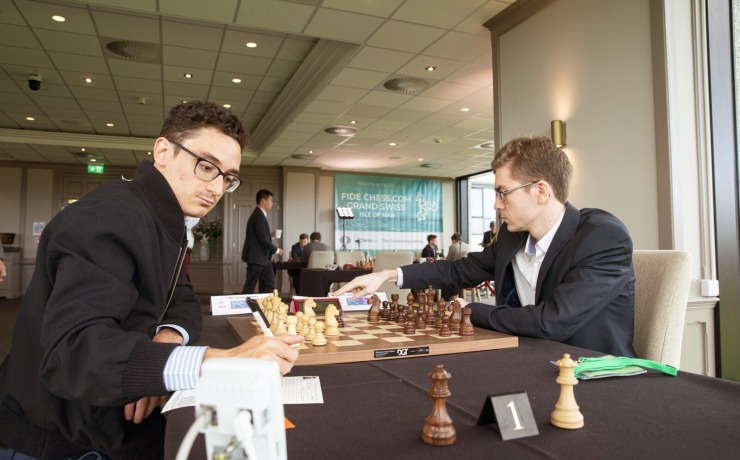 (Photo: Maria Emelianova/Chess.com)
(Photo: Maria Emelianova/Chess.com)
The next few moves brought about the exchange of knights and Black winning a pawn, but at a price of his king being further pushed away from White’s passing pawns. With cutting the board in two with his rook on e6, White could effortlessly advance his pawns supported by the king without any serious threats to them. At this point, Black had just one option at his disposal – to push his own pawns on the queenside and hope for a wonder.
In the moves that followed, David Anton finally gave up his rook for White’s pawn on g7, putting everything on the queen promotion of his pawns on the queenside. Caruana was, however, one step ahead – although Black did promote a queen as well, white had the decisive check which was a prelude to a deadly attack. The Spaniard resigned and was, effectively, kicked out of the race for the top.
With this win, Fabiano Caruana (who is on 7.5/10) became the sole leader of the tournament with just one round to go.
The battle of the slow-starters
The board two saw a clash in the Rui Lopez between two slow-starters in the tournament: Hikaru Nakamura and Levon Aronian.
Black (Aronian) quickly castled on the kingside and launched an attack in the centre, while White’s king was still on the e-file. This was, however, followed by an exchange of pieces in the centre, including the queens, leaving Aronian with an isolated pawn on d6. The two sides were even: Aronian’s position seemed more natural while Nakamura had a bishop on a3 which was somewhat out of action due to his pawns being in front (a4, b4, and c3).
On move 16 Levon Aronian thought for over ten minutes, although the position was pretty forced. Further exchanges of pieces in the centre ensued and the two entered a four-rook endgame. The position was slightly better for white but hardly more. The game ended with both players splitting a point after two and a half hours of play.
Carlsen achieves a 100-game streak without a loss
The World Champion Magnus Carlsen had a somewhat odd tournament: in the beginning, he was very fortunate to escape loses not without help from his opponents missing winning moves; in the second part he picked up speed and found his rhythm, but his top competitors managed to hold him to a draw. The World Champion was always lurking in the background but was missing a key breakthrough to the very top.
In the round 10 game against the 2017 European Champion, Maxim Matlakov, history repeated itself: the two met in the Tata Steel tournament in 2018 when Carlsen also had white pieces and played a very long game in which the World Champion managed to edge a win in the very end. Their encounter in the Isle of Man Grand Swiss followed a somewhat similar scenario.
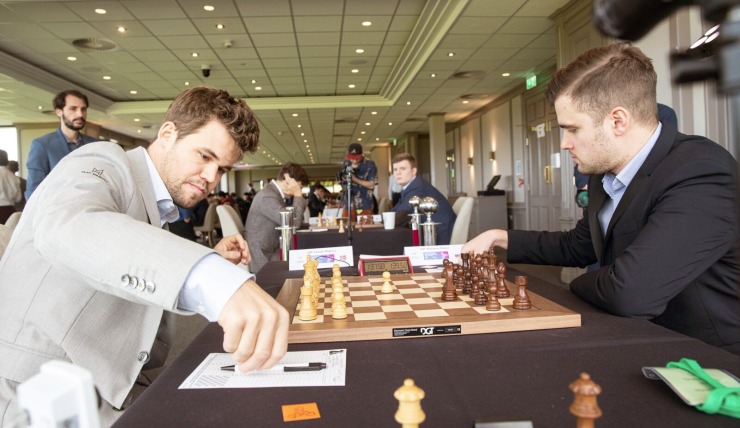 (Photo: Maria Emelianova/Chess.com)
(Photo: Maria Emelianova/Chess.com)
Carlsen achieved – according to the computer – a completely winning position well before the 40th move, but Matlakov managed to squeeze out and play on.
The game started with a complicated position in the Semi-Slav defence which opened up at one point. Matlakov spent significantly more time, which suggests that he walked into a good preparation by Magnus Carlsen. Black managed to create a protected passed pawn on c3 but had only 12 minutes on his clock with 17 moves to the first time control.
With a series of precise moves Carlsen obtained a very comfortable position: he opened up the f-file, directly aiming for the black’s weak spot on f7, and centralized his rooks (on d6 and f4). The situation seemed desperate for Black – with less than two minutes on his clock, Matlakov pushed his c3-pawn forward, but Carlsen took on c2 and then progressed with pressing on black’s weak spot on f7. White then took on f7 and Matlakov’s king started a long trip to the queenside, trying to escape Magnus’ deadly threats.
Maxim was down to a minute and 17 seconds for six moves and in dire straits. It was an important psychological moment of the game: Carlsen spent 15 minutes thinking, trying to find the most dangerous threat which could force Black to panic and blunder. Matlakov – limited for move options – played the best he could. The computer was still showing a huge advantage for White and it seemed that mate was around the corner. However, after Carlsen’s missing the strongest continuation on the move 36 (36.b5!), the Russian managed not only to escape and reach the time control but also get his pieces activated. Nevertheless, the best he could achieve was a rook and pawn against the queen endgame which Magnus conducted with surgical precision.
When he exhausted all of his options, slowing Carlsen on the path to his 100th game without a loss, the Russian finally resigned.
Wang Hao back at the top after Anand’s blunders
Just as he was making confident progress towards the top of the tournament, after a surprise loss in Round one, the former World Champion Vishy Anand tripped up the 10th game of the Isle of Man Grand Swiss, having blundered in a mostly even position against Wang Hao of China.
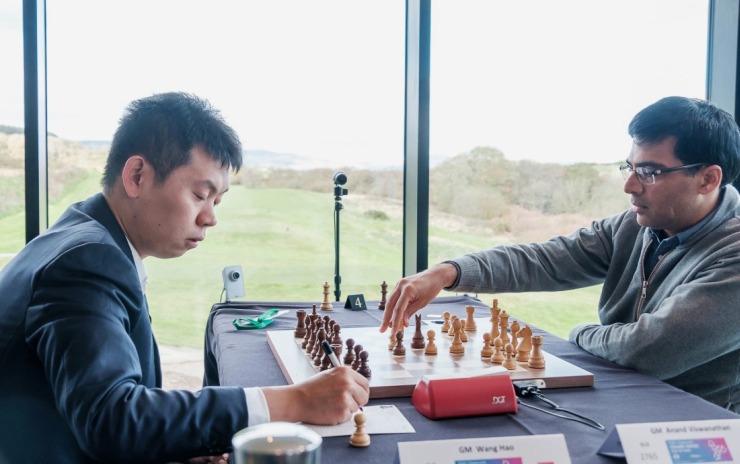 (Photo: John Saunders)
(Photo: John Saunders)
In Petrov Defence, both players followed theory for 17 moves and then quickly proceeded to an endgame in which Anand seemed to have slightly better prospects. However, in the post-mortem Wang revealed that in his preparation he had checked all the relevant lines after the 17th move and had concluded that there were no serious threats to him, even though his kingside castle was missing a pawn on h7.
After 22 moves the position was completely equal but demanded careful play from both sides. It was at that point that Anand blundered with 23.f5, and then 24.e6. As a result, White’s rook was left trapped on a3.
The final mistake from white was taking a pawn on e4 with his rook, leaving the first rank unprotected. Black aligned his rooks on the f-file threatening with either checkmate or winning a bishop. Anand instantly resigned and left the playing hall.
It was a somewhat abrupt end for the former World Champion.
Wang Hao enters the final round with the best tie break among all his competitors. All the Chinese GM wanted from this 10 round game – as he later confessed – was a draw, which would keep him in contention for one of the top places. Now he is among the very top with very good chances of securing a spot in the Candidates’.
Karjakin’s piece sacrifice in move eight ends in defeat
One of the most interesting games of round 10 was played between the former contender for the title of World Champion, Sergey Karjakin as white and Kirill Alekseenko. Karjakin decided to sacrifice a piece on move eight and played with a piece down until the (bitter) end!
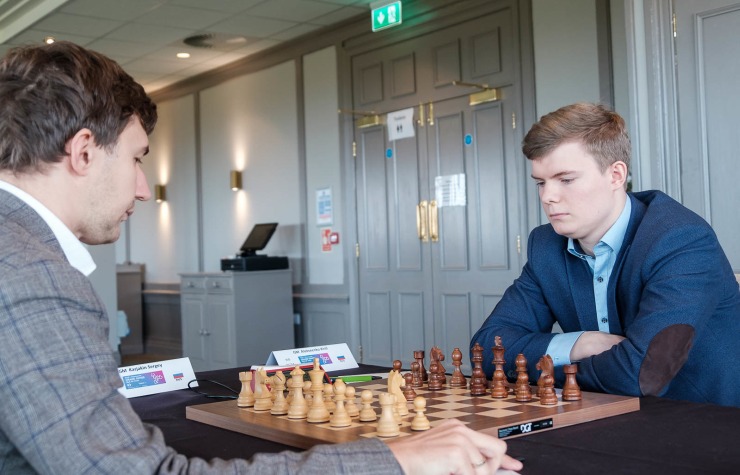 (Photo: John Saunders)
(Photo: John Saunders)
The cost of the knight was dear for Black: he had to give up three pawns, eventually winning one back, but White managed to implant his pawn to b7 and protect it. Karjakin then comfortably went on to exchange queens and proceed towards an endgame where he was still a piece down but had compensation: he activated his pieces and created dangerous threats along the 7th and 8th ranks, while Black needed time to get his kingside rook activated.
Time also played into Karjakin’s hands: Alekseenko had under three minutes for 18 moves. By his final minute, Alekseenko was still 13 moves away from the 40-move mark. White seemed confident – while his opponent was struggling to find the right move and reach time-control, Karjakin played almost instantly.
White then went for further simplifications. Eventually, however, Karjakin realised it’s hard for him to win so he offered a draw instead, giving the Black king several checks: from move 34 to move 44 Alekseenko made ten moves with his king, walking him to the centre of the board and then back to his kingside castle safety, gaining important time and reaching the first time control. By this stage, it had seemed as if the tables have turned on Karjakin.
By move 49, Black completely consolidated his position and confidently converted his extra bishop in a very important victory. Now Alekseenko is on 7/10 and with the second-best tiebreak (after Wang Hao) has serious chances to reach the Candidates’ in the final round.
Howell defeats Grischuk in a blitz marathon
On board six, England’s David Howell led the white pieces against Alexander Grischuk of Russia. Both players are notorious for getting into time trouble, and their duel in round 10 was no exception.
Howell struggled with the theory in the opening, spending about an hour on moves 10-13, after Black’s 9…Qc8. By move 25 the Englishman managed to take command of the centre and cleared Black’s queenside. Still, time was an issue: David Howell had under 17 minutes for 28 moves, While Grischuk was just slightly better in this domain.
The Russian managed to counter Howell’s initiative and get his pieces into the game. The Englishman was still much better but needed to be careful.
By move 20 the players were in the middle of a blitz game: Howell made his 23rd move with just 8 seconds on the clock! Both players had under a minute for 13 moves till the first time control. When the dust settled, Grischuk’s position was completely lost.
A great turnaround for the three-time British champion who started with a loss in the first round and was on 50 per-cent after the first five rounds, but managed to get 4.5 points in the last five games.
With this victory, David has not only reached the top group behind Caruana but, also, passed the 2700-mark and overtook Mikey Adams as England’s top player.
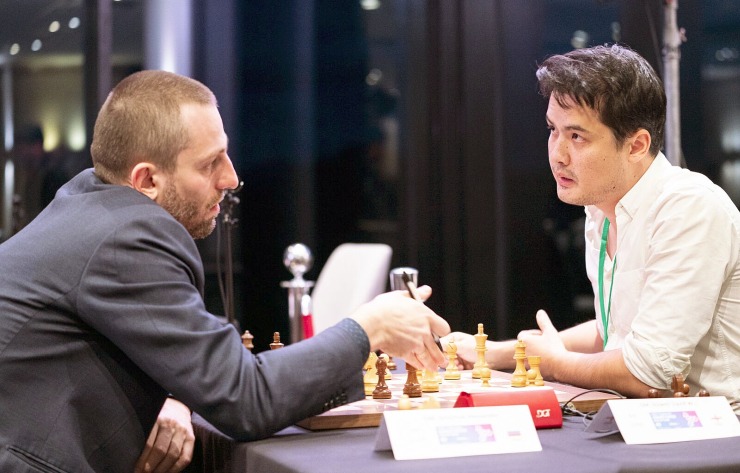 (Photo: Maria Emelianova/Chess.com)
(Photo: Maria Emelianova/Chess.com)
Parham Maghsoodloo drops out of the top tier
By round ten three other players were also in contention for the top spots: Nikita Vitiugov, Aleksandr Rakhmanov and the Junior World Champion Parham Maghsoodloo.
Vitugov managed to secure a solid position in the opening against Aleksandr Rakhmanov, going on to take initiative in the centre. After 28…Ra7, Black was lost as he overlooked an exchange sacrifice on e6, leading to a winning position for White. Vitiugov went on to bring all his pieces into the attack on the black king, eventually forcing Rakhmanov to resign.
One of the tragic figures on top boards was Iran’s Parham Maghsoodloo who was unbeaten for nine rounds but lost in round ten to Vietnam’s Le Quang Liem who was on 5.5 points and has no chances to progress to the top even with this victory over the Iranian.
Harika Dronavali and Alina Kashlinskaya heading for the top female prize
Indian GM Harika Dronavalli and Russian GM Alina Kashlinskaya both drew games against their opponents in round ten and have 50 percent which makes them the top-performing women players at the Grand Swiss (out of a pull of 18 women competing in the event).
Dronavalli has a better tie break than the Russian and so far stands most chances of winning the top female prize of 10.000 US dollars, but everything will be decided in the final round.
Kazakh player Dinara Saduakassova also drew her game today (she is now on 4.5 points) and completed the GM norm.
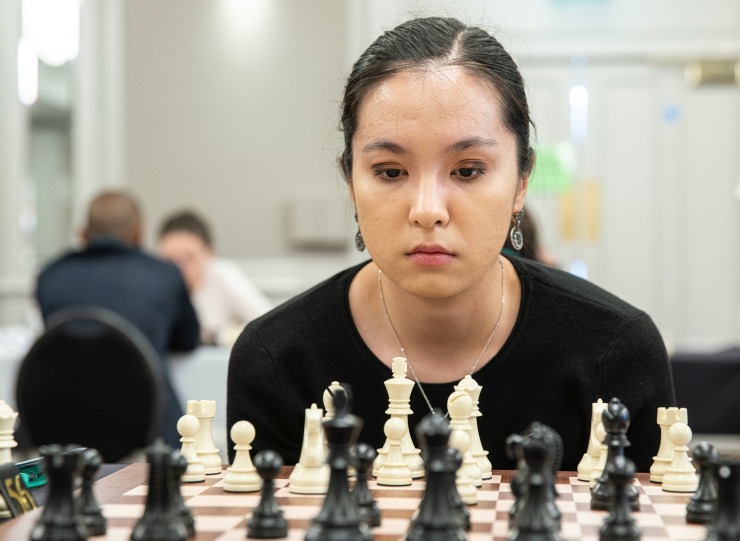 (Photo: Maria Emelianova/Chess.com)
(Photo: Maria Emelianova/Chess.com)
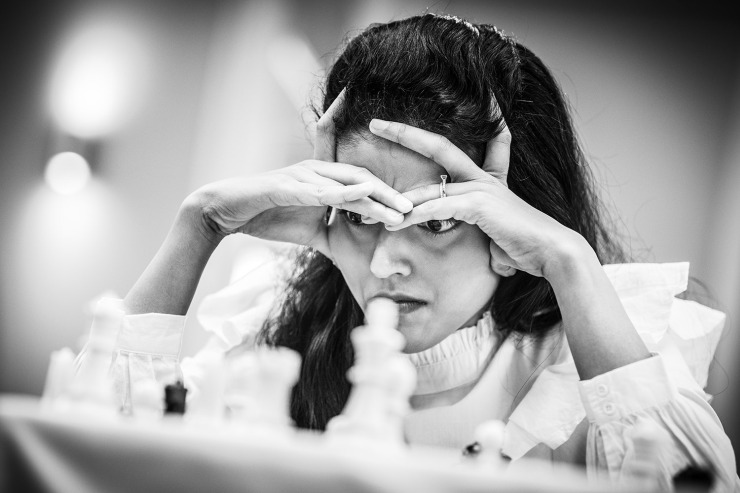 (Photo: David Llada)
(Photo: David Llada)
Text: Milan Dinic
Photos: David Llada, Maria Emelianova/Chess.com, and John Saunders
IOM International Chess Limited:
Tournament Director Alan Ormsby
masters@iominternationalchess.com
+44 7624 453200
Chess.com:
Director of Esports and Events Nick Barton
nick@chess.com
+1 8326223010
FIDE:
Chief Communications Officer David Llada
press@fide.com
+34 680312625








